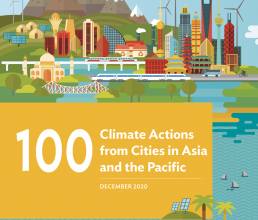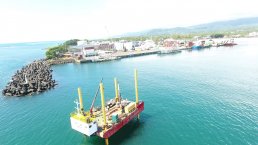First appeared in

Asian Development Bank
100 Climate Actions from Cities in Asia and the Pacific
A variety of initiatives and the construction of maritime infrastructure are underway at the Port of Apia as part of efforts to increase the resilience of the harbor.
A variety of initiatives and the construction of maritime infrastructure are underway at the Port of Apia as part of efforts to increase the resilience of the harbor.
Samoa’s geographic isolation makes its only international maritime gateway, located in Apia, extremely important. However, port operations are presently constrained by seasonal waves and the current breakwater is inadequate to withstand climate change and natural disaster impacts.
2.5
METERS OF EXTRA BREAKWATER HEIGHT
The Pacific island is planning to improve its coastal management and enhance the efficiency and safety of its port. A larger terminal area will be constructed to meet projected demand, and wave monitoring and early warning systems will be implemented to enhance safety at the port.
The project will also strengthen the existing breakwater, as current modeling has revealed that it is unable to withstand 100-year storm conditions and an expected 50-year sea level rise of 0.4 meters. Existing structures will be reinforced, the height and width will be increased, and new stormwater drainage will decrease vulnerability to flooding. Together with a multi-hazard preparedness plan, these measures seek to mitigate disruption to port operations in the aftermath of natural disasters. The project will also support gender-sensitive green port initiatives (GPIs) to promote clean and sustainable port operations and management.
The project is financed in part by a sovereign project grant from ADB.

Satellite data indicates that sea level rise near Samoa is already larger than the global average, with even greater increases expected in the future (photo by Samoa Ports Authority).
The Challenge
As the country’s only international maritime gateway, the Apia Port is critical to the economy. Currently, the seaport terminal capacity is insufficient and the severely damaged breakwater is inadequate to withstand climate change impacts and natural disasters.
Co-Benefits
Social The use of locally sourced rock will benefit local contractors, and opportunities for local skilled and unskilled labor will be created.
Health Measures designed to decrease disruptions to port operations will ensure residents are able to receive aid and emergency supplies when necessary.
Economic Greater capacity and efficiency of port operations will increase the flow of trade and inter-island travel, and reduce the cost of doing business.

